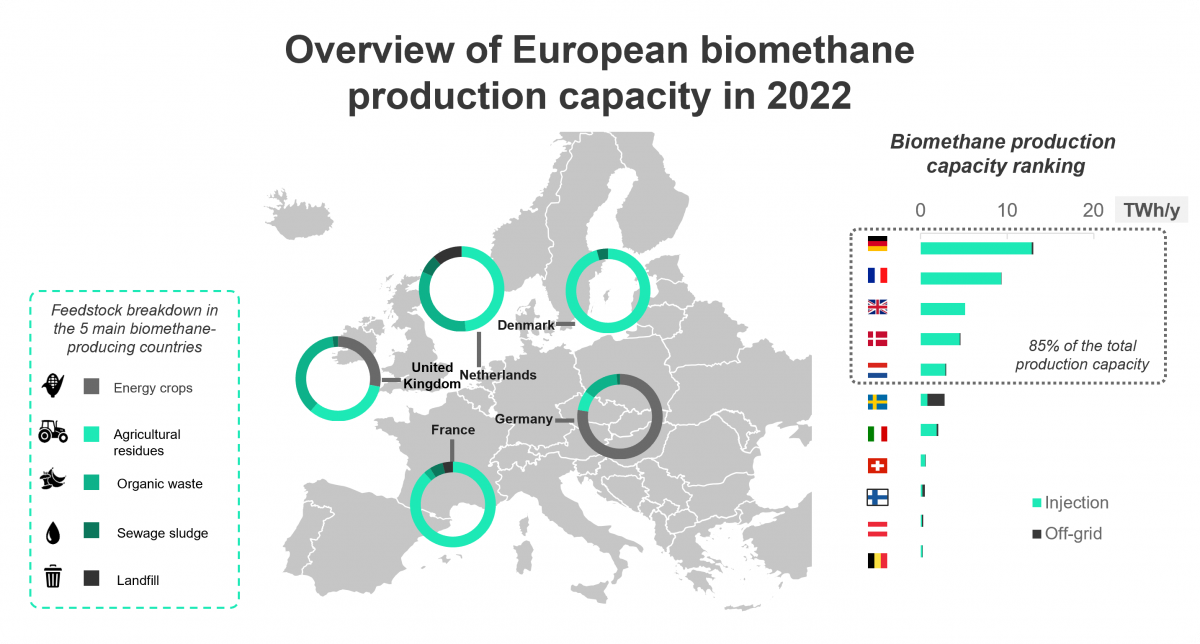Carbon Accounting Management Platform Benchmark…

The European biomethane sector is expanding amid rapid regulatory changes and now counts over 1,200 operational plants.

There has been a 17% increase in registered plants in 2022 compared to 2021. Of the existing 1,200 biomethane plants, 90% are already connected to the grid, contributing 37 TWh of biomethane injected into the grid.
Biomethane plants currently represent a total raw biogas upgrading capacity of 0.9 million cubic meters per hour and a biomethane production capacity of 44 TWh in 2022, which is equivalent to 4.2 bcm. By reaching this milestone, European biomethane producers have now reached 12% of the 2030 target of 35 bcm.
However, there is a clear potential to expand biomethane production, as only 6% of biogas plants in Europe are registered as biogas upgrading units.

Agricultural residues including manure, crop residues and intermediate crops, amount to 43% of the feedstocks used compared to 39% in 2021, reflecting a shift towards more sustainable feedstocks.
The majority of existing biogas plants are supplied by agricultural residues, energy crops and organic waste. Agricultural residues account for 43% of the total feedstocks used in Europe, mainly in France. Since 2019, the use of agricultural residues as a feedstock has increased by 70%, representing a promising way to reduce methane emissions from agriculture which is causing more than half of European methane emissions.
Energy crops account for more than 27% of the total feedstocks and are particularly popular in Germany and the UK. However, their uses have been gradually declining, as no new plants have been established since 2019.
Organic waste which is derived from both municipal and industrial sources is increasingly used as feedstock and now makes up 21% of the total mix. By extracting value from waste, biogas and biomethane play a vital role in contributing to the circular economy.
Since its introduction in 2017, landfill gas usage has more than quadrupled, yet it accounts for only 2% of the total mix.
Over the past few years, the biomethane sector has experienced steady growth in Europe. Biogas upgrading capacity increased by more than 30% in 3 years, growing from 0.7 million cubic meters per hour (3.2 bcm) in 2019 to 0.9 million cubic meters per hour (4.2 bcm) in 2022.
This phenomenon mainly results from strong growth in several leading countries, particularly in France where 149 new biomethane units have been commissioned in a single year (+41%). Smaller players like the Netherlands, Finland, Italy, and Belgium are following suit. Meanwhile, established countries like Germany, which still has the highest number of biogas units and biomethane production capacity in Europe, Austria, Denmark, and Sweden remained stable over the past few years.
Biomethane makes up less than 1% of Europe's gas consumption, while Europe is currently using 4% of its anaerobic digestion potential, suggesting that the sector still holds huge potential to reach the 2030 target of 35 bcm.

Countries display distinct levels of anaerobic digestion deposits and diverse levels of utilization. Presently, 4 bcm is produced annually out of a total potential of 90 bcm that can be achieved through anaerobic digestion using readily available feedstocks. In total, this accounts for 4% of the overall deposit and less than 1% of the gas consumption. However, the untapped potential in Europe is substantial with 161 bcm when including gasification. This surpasses the targeted 35 bcm by more than four times.

To reduce reliance on government funding, countries are increasingly adopting instruments such as tendering systems and quotas as the preferred mechanisms to enhance the integration of biomethane into the gas and fuel mix.
Countries with well-established biomethane industries are shifting from investment subsidies and feed-in tariffs to tendering systems, aiming to encourage the industry to lower its costs and reduce dependence on support mechanisms. In parallel, the introduction of biomethane quotas applied to energy suppliers, notably in France and the Netherlands, is an effective measure to increase the integration of biomethane into the energy mix. Some countries are also raising quotas for renewable fuels, aligning with the mandates outlined in the Renewable Energy Directive (RED II). Additionally, some countries are incentivizing the use of biomethane as a fuel by offering consumption and carbon tax exemptions.
The increasing valorization of CO2, the transition to bio-LNG production, and the increasing number of contracts between producers and industrial partners highlight the dynamic nature of the market.
A noteworthy trend among biomethane producers involves diversifying business models through the valorization of CO2 separated during production. This CO2 finds applications in diverse industries, including agri-food and medical sectors. Additionally, some producers are shifting to the production of bio-LNG, playing a role in the decarbonization of the expanding transportation sector.
Additionally, the use of biomethane as part of the Emissions Trading Scheme (ETS) encourages the development of this sector considerably. The economic incentives provided by the ETS create a favorable environment for the emergence of contracts between biomethane producers and industrial consumers. To date, at least a dozen of such contracts have been signed.
The growing number of acquisitions in the sector and the creation of the Industrial Partnership for Biomethane reflect a commitment to accelerate, expand and industrialize the sector on a European scale.
From 2022 onward, the sector has seen numerous acquisitions, with some notable instances including ENGIE, Shell, and TotalEnergies announcing or finalizing acquisitions in various European countries. This illustrates the determination of producers to continue their expansion in Europe and industrialize their operations. Various entities along the value chain actively participate in the Biomethane Industrial Partnership (BIP), a collaborative initiative introduced in 2022. The BIP involves industrial stakeholders, policymakers, and other key players in the biomethane value chain, collectively striving to accelerate biomethane development on a European scale.